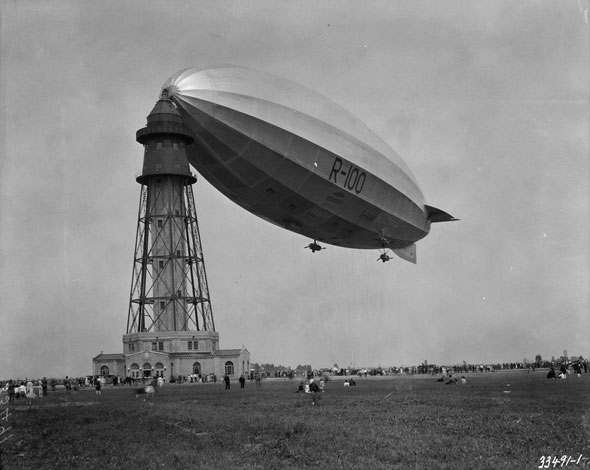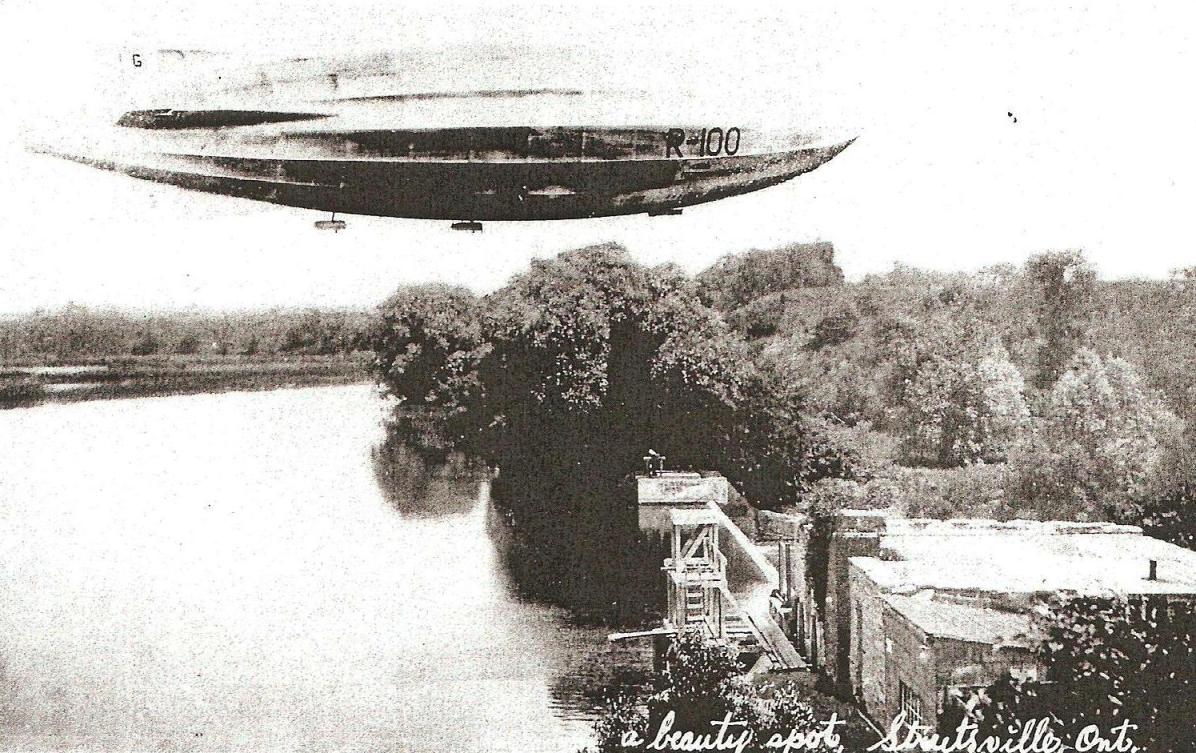A few weeks ago, I wrote about Mississauga connections to the collections of the Canada Aviation and Space Museum in Ottawa. One of the “connections” I did not mention involved a model on display – that of an airship.
On August 11, 1930, a giant airship called R100 flew over historic Mississauga. Specifically, its route followed the Credit River Valley as it made its way from Niagara Falls to Toronto. Strong headwinds had forced the ship to alter course, and it endeavoured to stay low in the valleys to make up time against the prevailing winds. This route, bucking the winds, brought the airship low over the power dam on the Credit River in Streetsville.
The R100 story started in Europe where in the 1920s Great Britain felt that it was being left behind in the development of airships. Germany was far ahead of the rest of the world, with its Graf Zeppelin making a round-the-world flight in 1929. To correct this deficiency and to improve communications with the countries of the Empire, Britain ordered two airships in 1924, both to be built to the same specification.

R100, which was to be built by private enterprise, was to fly to Canada to demonstrate the viability of a commercial airship service across the Atlantic. R101, to be built in a government facility under the supervision of the Air Ministry, was to fly to India. Both airships would be considerably faster than ocean liners.
R100 flew from Britain to Montreal, where it was tied up to a specially built mooring mast at Saint-Hubert airfield on the southern outskirts of that city. From there the airship made a 24-hour round trip to Ottawa, Toronto and Niagara Falls, before returning to England. These events occurred in July and August of 1930.
R-100 left its base at Cardington, about 45 miles north of London, England at dawn on Tuesday, July 29, 1930. The Atlantic crossing was uneventful and before daybreak on Thursday, July 31, the airship was well inside Newfoundland and followed the St. Lawrence River toward Montreal.
Before reaching Quebec City the airship ran into some severe turbulence which caused a few rips and holes in the outer cover of the ship near the tail fins. Fortunately, it was possible to make some temporary repairs and the ship was able to proceed on its way, though at a slightly reduced speed.
At dawn on Friday, August 1, 1930, R100 was moored at its mast at Saint-Hubert airport. The trip had taken 78 hours at an average speed of 42 mph. This, being about half the time taken by ship and train from London to Montreal, gave some promise of commercial viability.
Montreal gave R100 a wonderful welcome. More than 100,000 people visited Saint-Hubert every day for several consecutive days, and contemporary photographs show long line-ups of people waiting to ascend the mooring mast and file through the public rooms of the huge airship.

The ship was a great attraction all along her route. There are photographs of R100 over Montreal and Toronto and Niagara Falls, and many other places. The return trip back from Niagara Falls brought R100 over Streetsville and the Credit River. Local historian Verna Mae Weeks witnessed the passage of R100 and in My Villages of Mississauga, she reminisced that it “suddenly and silently glided into view, seeming to come right past the corner of our house.

It sailed straight ahead through the sky, resembling a long, slim, silvery grey loaf, appearing to have very smooth and very hard sides and creating the impression in my mind that it could be evenly sliced, like a loaf into firm grey slices. Painted in large black letters on the lower part of the side was its name, R-100.”
The airship did not linger in Montreal after its demonstration flight to Toronto and Niagara Falls. A few days after her return, R100 slipped her mooring at Saint-Hubert, made one last flight over Montreal, and then headed eastward for an uneventful return journey to Britain.
R100’s sister ship did not fare well on its maiden flight to India just a few months later. In early October, R101 left Cardington, but hours later it crashed in France killing most of those on board. The tragedy put an end to Britain’s involvement with giant airships and within a very short time R100 was broken up for scrap.
Special thanks to the late Eric Gibson and the late Bob Lang for information on the journey of R100.




Comments are closed.